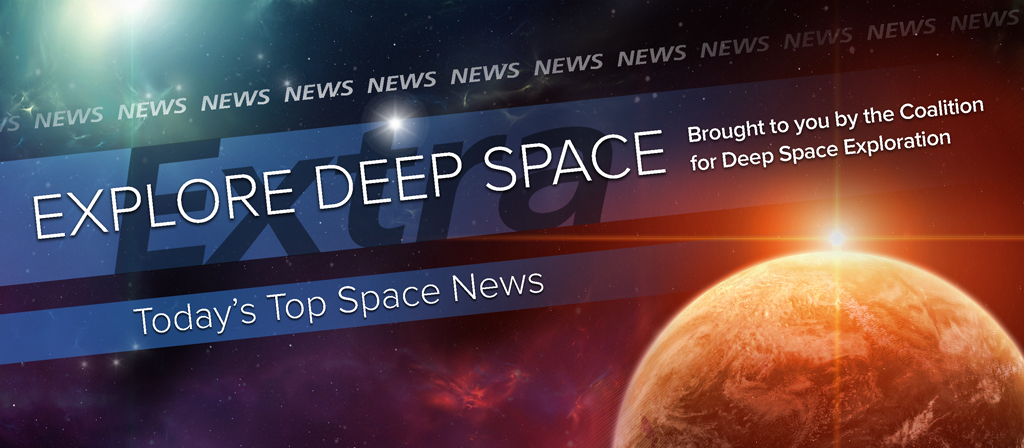The Humans to Mars Summit will be held in Washington D.C. today through Thursday, May 17-19. It will include an exciting array of speakers and topics, include Deputy Administrator of NASA Dava Newman, Astronaut Buzz Aldrin, and the author of The Martian, Andy Weir. Streaming begins at 8:30 a.m. EDT. Follow along on Twitter using #H2M2016 or click here to view the livestream.
In Today’s Deep Space Extra… Those preparing for the human exploration of Mars seek a new reconnaissance satellite to help locate landing sites with high science value and resources.
Human Deep Space Exploration
Humans on Mars: Scouting needed for Red Planet resources
Space.com (5/16): Mars experts support a new NASA orbital reconnaissance mission to the red planet to help scientists and planners select a landing site for future human explorers. The ultimate site would have high science interest as well resources, such as ground water or ice that could help provide early Martian explorers with their life support and rocket propellant needs.
The Martian Scientist
Huffington Post (5/16): On the slopes of Hawaii’s largest volcano, astrobiologist Cyprien Verseaux and five other scientists are getting a taste of the isolation and other challenges of living and working on Mars. Their NASA sponsored outpost analogue, HI-SEAS IV, is a small white dome with limited communications and few supplies. “Before the mission, I had to think of everything I would need for a year, down to the smallest detail. Then I had to cut it down to adequate volumes and masses. But in spite of this thorough planning, I often have to improvise,” writes Verseaux, who is eight months into his yearlong simulated say on Mars.
Space Science
Why dying stars may be a good place to look for alien life
Washington Post (5/16): There’s an assumption that intelligent life elsewhere in the universe — if it exists — will be found around planetary systems much like ours. However, two Cornell University experts believe more ideal conditions may exist around star systems far older.
Remains of giant asteroid found in outback Australia
Cosmos (5/17): Scientists believe they’ve found the remains of a giant asteroid impact in northwestern Australia. The object, perhaps 40 kilometers — or 25 miles — wide, struck nearly 3.5 billion years ago, influencing how the crust of the young Earth was forming.
Low Earth Orbit
More frontiers lie ahead as International Space Station makes its 100,000th orbit
The Geek Wire (5/16): The 15 nation International Space Station logged its 100,000th orbit of the Earth on Monday. Since the launching of the first major module in November 1998, the space station has logged more than 2.6 billion miles, enough to equal 10 round trips to Mars, according to NASA.
School kids launch out of this world science project
CBS News (5/16): Students from the Thomas More Cathedral School in Arlington, Va., watched eagerly early Monday as their CubeSat, STMSat-1, was deployed from the International Space Station. The student initiative will transmit images of the Earth back to students from around the globe.
Scott and Mark Kelly, NASA’s astronaut twins, to be honored by hometown
Space.com (5/16): The only twin astronauts, Scott and Mark Kelly, will be honored this week in their hometown of Orange, N.J. Now retired, both were selected by NASA for astronaut training in 1996. Scott recently became the U.S. spaceflight pacesetter after completing a 340 day mission. He logged 520 days in space over four missions before his retirement.
David Saint-Jacques will be third Canadian to spend months in space
The Ottawa Citizen, of Canada (5/16): Canadian Space Agency astronaut David St. Jacques, 46, will be the next from his country to live and work aboard the International Space Station. The medical doctor/astrophysicist will train to launch in 2018 and serve as Canada’s third ISS resident. Navdeep Bains, Canada’s Minister of Innovation, Science and Economic Development, announced the assignment on Monday. St. Jacques follows Chris Hadfield and Bob Thirsk.
Commercial to Low Earth Orbit
NASA to pay Russia $88 million to deliver astronauts to world’s sole orbiter in 2018-2019
TASS, of Russia (5/16): The price for NASA to launch astronauts to and from the International Space Station aboard Russian Soyuz rockets will climb to $88 million in two years. Ahead of that point, NASA intends to resume launching astronauts to the station aboard the Boeing CST-100 Starliner and SpaceX crewed Dragon, both under development with the space agency’s Commercial Crew Program.
The Space Review (5/16): The small satellite form is growing in volume as well as popularity. Now, some are wondering if there is a market for satellites even smaller than the basic 10 cm cubed form of the CubeSat. Satellites as small as 3 cm on a side and weighing no more than 35 kg are being pondered, writes TSR editor Jeff Foust.
Effects of changing economics on space architecture and engineering
The Space Review (5/16): Essayist Gary Oleson examines the growing space economy and key forces behind it, new technology and systems design that enable services to be provided at lower costs. Smaller spacecraft and emerging smaller launch vehicles are a part of a shifting trend. Oleson is a senior engineer in the Space Systems Sector of TASC.
Suborbital
Virgin Galactic’s CEO: We’re at an inflection point for space travel
Fortune (5/17): George Whitesides, CEO of Virgin Galactic, the suborbital space passenger and launch services company, believes space travel could be common soon. “We’re at an inflection point,” Whitesides says. “Only about 550 people have ever gone to space. Come back in 10 years and thousands of people will have gone.”

